Live chat has become one of the fastest-growing support channels, and the latest live chat statistics show why. Customers’ patience is shrinking. They don’t want to hold the line for hours or wait a day for email replies.
In fact, 40% of businesses plan to invest in live chat for customer support. Adoption is increasing as well, particularly as CX teams look for more high-personalization, low-friction ways to manage customer interactions.
Below, we break down the most important trends and data shaping live chat in 2026.
Current State of Live Chat in 2026
Live chat has become a mainstream support channel, not a niche feature. Back in 2023, 53% of U.S. online adults used live chat to get help from a company, and 58% of them used it specifically for customer service.
Adoption has only accelerated since then. Today, according to BuiltWith, over 515,000 websites have live chat embedded. This means live chat will become a core part of the customer experience stack in 2026.
Here are some of the biggest benefits behind the growth of live chat:
- Instant support: Customers get real-time replies without waiting on hold or refreshing their inbox.
- Higher conversion rates: Live chat engages people while they’re already browsing, making it easier to turn questions into sales.
- Lower support costs: One agent can handle multiple chats at once, reducing workload compared to phone support.
- Better customer satisfaction: Fast answers and a human-like chat experience lead to higher CSAT and stronger loyalty.
- Better sales: Live chat increases sales by giving customers instant answers at the exact moment they’re deciding whether to buy.
- Automation: AI chatbots handle common questions, route requests, and gather details before an agent steps in.
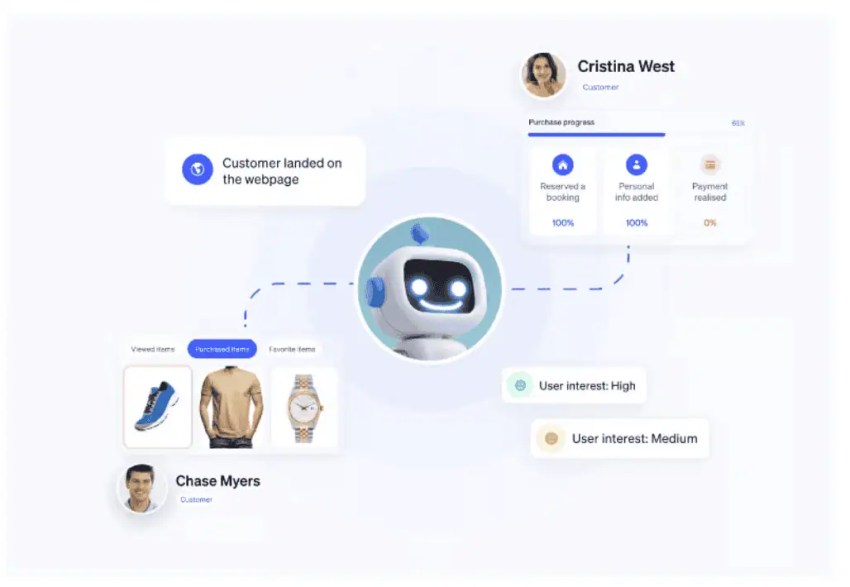
AI in Live Chat
Artificial intelligence in customer service is transformative in how companies deliver live chat support. It streamlines processes, reduces average response times, and helps customer support teams meet growing customer expectations for fast, personalized service.
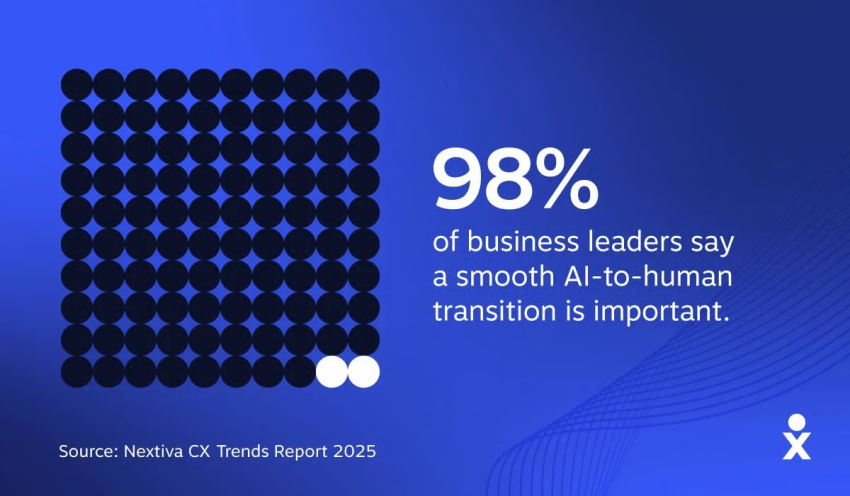
1. Live AI agent support is a top priority for optimizing AI-human workflows
More businesses are investing in live AI agent support, which offers real-time, behind-the-scenes assistance to help human agents deliver better service. For example, AI tools can suggest responses, surface relevant knowledge base articles, or flag sentiment, all while the agent is chatting with a customer.
In fact, 44% of companies say this is their second biggest area of focus for improving AI-human collaboration, just behind autopilot technologies. It’s part of a broader shift toward blending automation with expert human support to scale service without compromising quality.
Source: Nextiva
2. Generative AI enhances live chat support by enabling real-time translations and personalized responses
With generative AI, language barriers disappear. For example, it can translate a live chat between an English-speaking agent and a Spanish-speaking customer on the fly. Plus, AI can personalize replies based on context, making each interaction faster and more helpful.
Source: McKinsey
3. 38% of customers find it annoying when a live chat’s chatbot is unable to understand context
When chatbots give generic or irrelevant answers, it hurts the customer experience. That’s why 38% of customers say it’s annoying when chatbots can’t follow the conversation. Smarter, conversational AI that recognizes intent — not just keywords — can improve customer satisfaction and make chats feel more natural.
Source: Hiver
4. The average chat response takes 4 minutes to solve and costs $20
Here’s a clear live chat comparison: AI delivers answers faster and cheaper. A well-designed live chat tool can instantly provide shipping details, return policies, or product specs — questions that might otherwise clog up phone support queues or delay responses through email support. This saves money while still delivering real-time customer service.
Source: Nextiva
5. 60% of companies are implementing or planning to implement AI for agent-assist tools
A growing number of teams are using AI to support agents behind the scenes, from suggesting replies to pulling up relevant information during a chat. It’s a smart approach, especially since 33% of employees already worry AI might replace them. Agent-assist tools handle the repetitive work, and agents handle the human decisions.
Source: Nextiva
6. 98% of people say seamless AI-to-human handoffs are important
Even the most advanced AI has limits. When a conversation needs a human touch, customers want a seamless transition, without repeating themselves. This makes a strong case for implementing live chat solutions that balance AI efficiency with human empathy, ensuring that customer experience doesn’t suffer when issues escalate.
Source: Nextiva
Live Chat’s Impact on Customer Satisfaction and Sales
Live chat has become one of the highest-ROI channels in customer service. Live chat can increase conversions, speed up response times, and give customers real-time, personalized support.
With a market that’s forecasted to grow to $2.17B by 2033, it’s clear businesses are doubling down on chat as a core part of their CX stack.
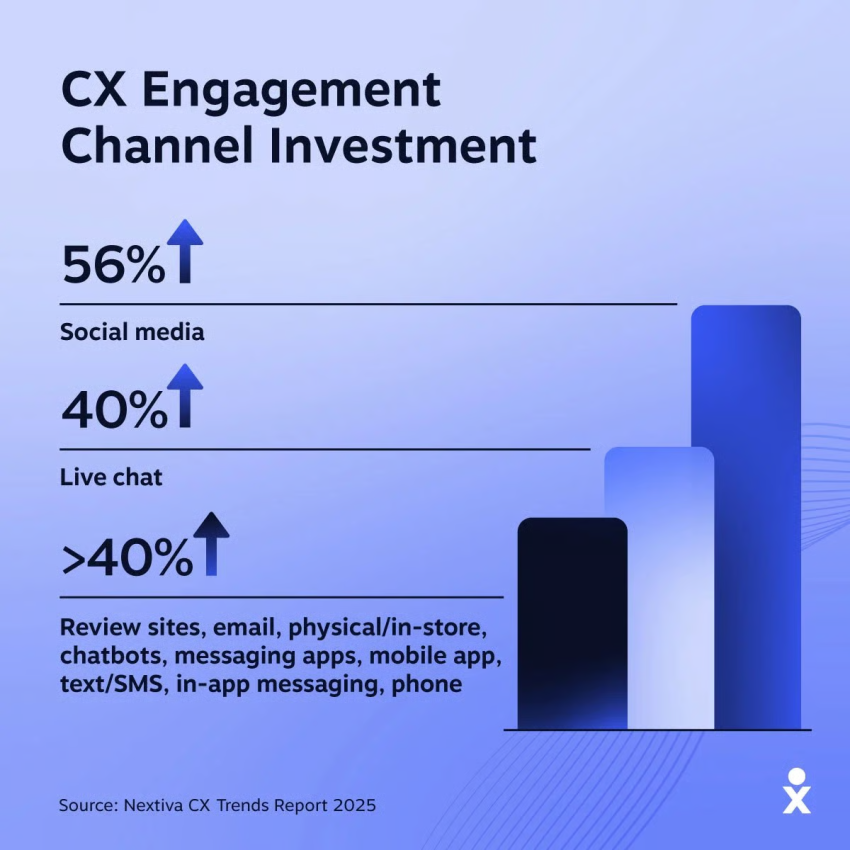
7. Live chat is the second largest area of investment among customer engagement channels
More brands are prioritizing live chat tools that help them meet customers where they already are. Whether that’s on a website, inside a shopping cart, or through messaging apps like Facebook Messenger, this level of investment shows how important live chat has become in modern digital customer journeys.
Source: Nextiva
8. The live chat market is expected to hit $2.17 billion by 2030
That kind of growth doesn’t happen without results. As more businesses see improvements in response time, efficiency, and customer satisfaction, demand for live chat software is expected to keep climbing. Businesses that want to keep up will need scalable, flexible live chat services that improve the customer experience without increasing customer support costs.
Source: IMARC
9. Online shoppers who use live chat are 513% more likely to become customers
That’s a massive lift. Say a shopper has a question during an online purchase about sizing or shipping. If they get help from a one-on-one live chat session, they’re far more likely to convert. These live chat leads represent high-intent prospects who simply need the right nudge to convert. Just think how many customers might be slipping away without that instant support.
Source: Tidio
10. Having to repeat themselves is a constant frustration for customers
About 16% of businesses say their customers get most annoyed when they have to repeat themselves during a chat. And 9% of customers also feel the same. This often happens when teams use siloed CX tools that don’t share information across channels. This is also why 81% of businesses plan to consolidate their CX tools in 2025 and beyond.
11. Adding live chat increases conversion rates and revenue
Live chat support offers customers immediate answers, guiding them through purchase decisions faster and more confidently. According to recent data, 51% of consumers are more likely to keep buying from an online store that offers live chat support.
Source: WPBeginner
Live Chat Speed and Performance Benchmarks
Live chat success mostly comes down to how quickly teams respond and how efficiently they resolve issues. This means live chat metrics like wait times, response times, resolution times, and CSAT scores. The strongest teams keep replies fast and use AI and automation to remove the slow, repetitive steps that usually drag agents down.
12. Average wait time is under two minutes for top-performing teams
The best live chat teams keep their first response under two minutes, and customers feel the difference immediately. In 2024, average wait times actually crept up to 23.6 seconds, with the biggest delays happening in large teams that struggled to manage higher chat volumes.
Smaller teams, on the other hand, kept response times steady thanks to tighter workflows and more personal attention.
Source: Comm100
13. Responding within 10 seconds can boost satisfaction above 84%
Speed is one of the strongest predictors of how customers feel about a support interaction. When someone gets a reply within 10 seconds, it signals that their issue matters and that alone can push CSAT well above 84%. Quick responses also reduce anxiety, prevent drop-offs, and ensure the conversation starts on the right note.
Source: LiveChat
14. 26% say customer inquiries are too complex for AI to handle alone
For many businesses, customer questions still require human answers. That’s also why 39% use AI mainly for generative writing — quick drafts, summaries, and suggested replies — while only 16% rely on it for proactive issue resolution. This makes AI-to-human handoff especially important.
Source: Nextiva
15. Tracking metrics like concurrency and average response time helps optimize live chat efficiency
Monitoring live chat metrics like concurrency (how many chats an agent can handle at once) and average response time gives teams a clear picture of both service speed and service quality. This matters a lot because in most cases, 95% of consumers say they’re OK with slower support if the quality is good.
Source: Kayako
Customer Preferences and Behavior
Customer behavior is shifting, and we’re seeing live chat becoming a preferred communication channel. People are using it for more than just quick answers. They’re using it because it matches how people prefer to engage with brands. These stats show why live chat tools are now essential for meeting modern customer expectations.
16. Live chat, when automated with bots, can convert around 4% of website visitors into qualified leads.
Automated live chat converts well because it meets customers at the exact moment they have a question or buying intent. Instead of waiting for an email reply or navigating your site on their own, visitors get instant answers, personalized recommendations, and frictionless next steps.
Source: Tidio
17. High spenders prefer brands with live chat
If your business serves customers who spend between $250–$500 a month online, live chat can make a big difference: 63% of these high-value shoppers are more likely to buy from companies that offer live chat support. Ignoring this preference could mean missing out on immediate revenue and long-term customer loyalty.
Source: Kayako
18. 52% of consumers stay loyal to companies that offer live chat support
When you offer live chat support, you’re building trust and brand loyalty with every problem you solve. This reliable, personalized customer experience is what keeps people coming back.
Source: Kayako
19. 63% of consumers are more likely to return to a website that offers live chat
Positive live chat experiences have a lasting impact. When customers know they’ll get quick, reliable help, they’re more likely to come back. It’s one of the clearest signs that live chat customer service fuels customer retention.
Source: SaaSworthy
20. Consumers think the live chat experience can be a lot better
While 38% of customers are frustrated with a poor live chat user experience, 43% think there’s room for improvement. The main reasons for this dissatisfaction include long pre-chat forms, chats getting disconnected, and support reps not being available.
Source: Kayako
21. Customers are more likely to buy again from a company if it offers live chat
Real-time guidance during the shopping journey has shown an increase in the average order value. Customers who chat during their purchase are more confident in their purchase (and your brand) and are more likely to add more items to their order.
Source: Kayako
22. 60% of millennials prefer live chat over email and phone
Millennials are shaping the future of customer service channels. They value speed and convenience, and they expect communication to happen in real time. Live chat matches their preferences perfectly, making it a must-have for brands serving younger demographics.
Source: WhosOn
23. Word of mouth is influenced by both good and bad chat experiences
While 20% of people say they’ll mention a poor live chat experience, even more — 29% — say they’ll share a good one. So if you create a well-thought-out chat experience, it has the potential to spark positive word of mouth and lead to more sales.
Source: Kayako
24. 29% of consumers find scripted responses very frustrating
Almost one in three customers say the thing they dislike most in live chat is getting canned, copy-paste replies. This means it’s especially important for both agents and AI bots to personalize responses and avoid sounding robotic.
So even if an agent uses script templates, adding small touches like matching a customer’s tone (or emotion) can make the conversation more human.
Source: Kayako
25. 82% of customers would use live chat on mobile devices if available
With mobile browsing and shopping on the rise, customers want support wherever they are. To achieve this, businesses must optimize live chat support for mobile.
An easy-to-access live chat widget designed for smartphones and tablets ensures website visitors can reach out at their convenience, contributing to a more seamless and personal customer experience.
Source: SaaSworthy
26. Live chat earns higher satisfaction scores than email or phone
When it comes to customer satisfaction, live chat comes out on top. It earns a 73% satisfaction score, compared to 61% for email and just 44% for phone support. Customers appreciate the real-time, one-on-one help that live chat provides — without the hold music or back-and-forth of slower channels.
Source: eConsultancy
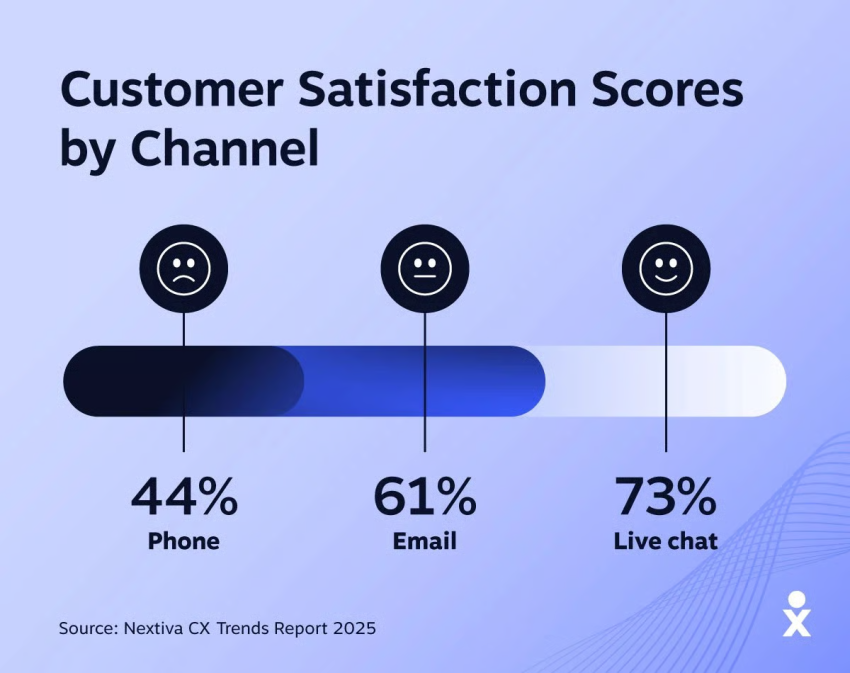
27. Over 75% of live chat sessions happen on mobile devices
With more than three-quarters of live chat sessions starting on smartphones and tablets, optimizing your live chat software for mobile isn’t optional anymore. This is more apparent in larger teams, which saw a 14.88% increase in mobile chats from 2023 to 2024.
Delivering real-time customer service through a mobile-friendly chat widget ensures a smooth, responsive experience that meets customers where they are and sets the tone for higher satisfaction from the first interaction.
Source: Comm100
28. Average live chat response time is faster than other channels
Speed matters in customer service, and live chat is great here. The average response time for live chat is just two minutes, far ahead of other support channels like social media (10 hours) and email (12 hours). Whether customers are resolving an issue or making a purchase, they expect quick answers. Live chat helps you meet (or beat) that expectation.
Source: SuperOffice
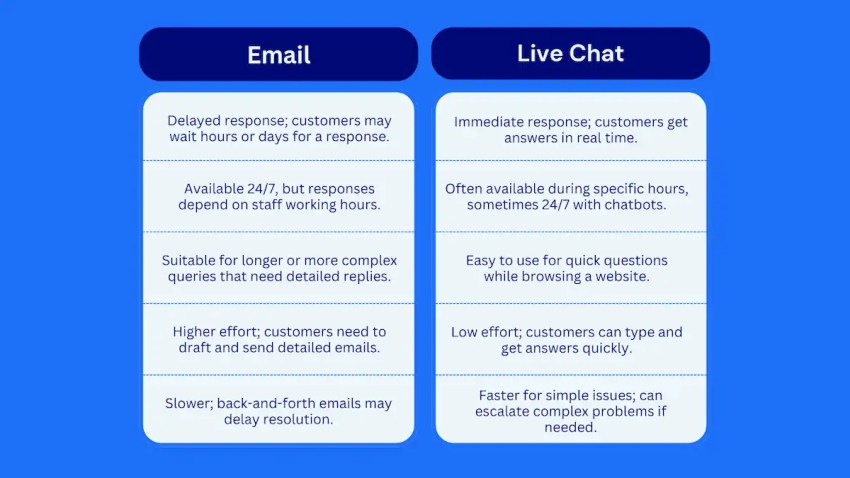
29. 60% of customers expect an immediate response when starting a live chat
Customers start a live chat session expecting to talk to someone instantly, not in five or 10 minutes. This expectation shows the need for well-trained live chat agents to be available and to handle multiple chats simultaneously.
Source: SaaSworthy
Best Practices for Optimizing Live Chat Performance
Strong live chat performance starts with giving agents the right context. When agents can see a customer’s history, recent activity, or account details, they avoid asking the same baseline questions and can move straight to solving the problem, which shortens handling time and reduces customer frustration.
Here are some best practices to make the most of your live chat widget:
- Use proactive chat prompts: Trigger chat invitations during high-intent actions such as checkout, form abandonment, or long pauses. This often solves issues before they become tickets.
- Provide quick reply options: Use buttons or short prompts for things like “Track my order.” This makes it easier for customers to take the next step.
- Automate routine work: Use AI bots to collect basic info, verify identity, or answer common questions so the agent steps in only when actually needed.
- Set clear expectations on wait time: Display estimated wait times and let customers know if an agent is reviewing their message. This reduces frustration and makes the interaction feel more responsive.
- Reduce handoffs with smart routing: Send each chat to the right agent by routing based on skills, department, or customer type. This cuts down delays and gets customers to someone who can actually help.
- Make escalations easy: Create clear ways for customers to reach a real person. Include an opt-out like “speak to an agent” in your live chat window so customers know a real human is available.
Here’s where a unified customer experience management platform like Nextiva comes in. It gives you live chat features that combine customer data, routing logic, and AI assistance in one place, so agents don’t have to switch tools or guess in the dark.
AI also handles the triage and repetitive lookups, while humans handle the complex tickets. This means you reduce handoffs and speed up responses, while maintaining quality interactions with customers.
Enhance Live Chat Performance with Nextiva’s AI-Powered Platform
Our live chat statistics confirm what many businesses already suspect: live chat is a standard part of multi-channel CX and an important key to a winning customer service strategy. From improving response time to aligning with customer behavior and preferences, live chat conversations are driving better outcomes and more effective customer service across the board.
To stay ahead, businesses need more than just a basic chat box. Our platform offers live chat software designed to enhance live chat metrics, provide personalized expert support, and empower customer support teams to deliver exceptional customer service at scale, regardless of the volume of daily live chat conversations.
If you’re looking to transform your live chat service into a strategic advantage, Nextiva helps companies of all sizes optimize every live chat interaction and give your customers the kind of service they’ll come back for.
Attend an upcoming personalized demo to see how to level up your customer experience.
Resolve customer issues instantly with AI chat support.
Resolve up to 60% of customer questions with Nextiva’s AI-powered chatbots for sales and support.

















 Customer Experience
Customer Experience 












